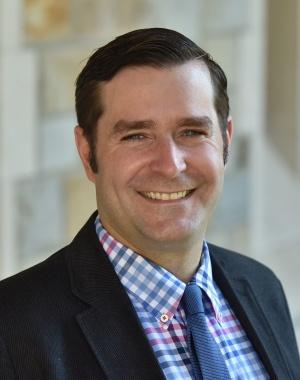
As the first chief economist in the U.S. Department of Education, Ford School alumnus Jordan Matsudaira (PhD ’05), seeks to identify and implement policies that best promote student success—academically and financially—in higher education. Ford School professor Kevin Stange has a one-year appointment alongside Matsudaira.
By George Spencer
Every person who’s ever solved a problem knows there’s a first time for everything. Take the U.S. Department of Education. In June 2022, the department appointed its first-ever chief economist. The new role will bring “positive economic analysis” to the policy table as the nation’s college-bound borrowers grapple with the seemingly intractable problem of student debt.

As an expert who thrives at the complex juncture of economics and public policy, Jordan Matsudaira (PhD ’05), has accepted the challenge. The Gerald R. Ford School of Public Policy graduate has long focused on using government administrative data to understand the causal impact of education and labor market policies on the economic outcomes of low-income Americans.
Matsudaira joined the education department as a Deputy Under Secretary when the Biden Administration took office in 2021, and since June, he has been doing double duty. U.S. Education Secretary Miguel Cardona created the chief economist role because the department holds data on 150 million loan recipients who’ve used federal aid to pursue higher education credentials; up until now, analysts have underutilized that data, Matsudaira says. In his new role, he is focused on designing data-driven programs to help create more equitable results for student borrowers.
According to Forbes, more than half of today’s college students leave school with debt, some 92 percent of which is generated by federal student loans. The federal student loan portfolio currently totals more than $1.6 trillion, owed by about 43 million borrowers.
“We want to incorporate [these people’s] stories into real-time decision-making to understand what levers to pull to promote student success and build a more inclusive, effective, higher education system,” Matsudaira says.
His efforts come at just the right time. In November, the Biden Administration’s plan to forgive tens of billions in student loan debt hit a legal roadblock. But in 2023, Matsudaira says, the department will announce new regulations around accountability and loan repayment plans, which go far beyond the accomplishments of previous administrations.
“In less than two years, the things we’ve already done in the higher education space are beyond historic,” he says.
Unfiltered assessment
Matsudaira sees his chief economist role as largely nonpartisan in the department’s policymaking process.
“Secretary Cardona expects me to give him the best assessment of what policies will most successfully promote student success,” he says.
“That analysis isn’t usually the end of the story, of course. Political factors determine policy choices we might make in some instances, but as chief economist, I try to make sure we are all aware in an unfiltered way what effect our actions are going to have.”
Betsey Stevenson, a Ford School professor of public policy and economics, served as the chief economist of the U.S. Department of Labor from 2010-11.
“The reason we have someone in that chief economist role is that economists are trained to do positive economic analysis,” she says. “They ask what will happen, not just what should happen—so, if we pass this policy, how will people change their behavior in light of the policy? That analysis is in many ways politics-free.”
Decisions and designs
After earning his doctorate in what was then an innovative new dual program in economics and public policy at Michigan, Matsudaira worked as chief economist with the White House Council of Economic Advisers during the Obama Administration. Under Obama, he helped create the College Scorecard, a data-rich tool designed for high school students to make informed financial decisions about pursuing their education. Prior to joining the Biden Administration, he was an associate professor of economics at Columbia University.
Making higher education more affordable ranks high for Matsudaira, especially considering Biden’s legal struggles to achieve student-loan forgiveness. He says the administration has proposed lesser-known lending reforms that promise significant savings for higher-education borrowers. One plan is to cap monthly undergraduate debt payments at five percent of discretionary income, down from the present 10-15 percent in existing repayment plans. In addition, loan balances would be forgiven after 10 years of payments for those whose original balance was $12,000 or less.
“We’ve devoted a lot of effort into developing models that help us understand how well borrowers are able to repay student loans based on their income trajectories, what kinds of programs they study, and their race, ethnicity, and background,” Matsudaira says. “We’ve helped people in the department and the White House understand how to design loan repayment plans to be as equitable and as impactful as possible.”
Such progress is a massive step toward increasing accessibility to college, he says. “This large reduction of the amount that lower-income people need to repay is going to make student loans a much less-risky way for students to finance higher education.”
Support system
Matsudaira’s staff comprises social science researchers, economists, and other experts.
Academic behavioral scientists and behavioral economists are experimenting with different methods and messaging to learn how to best support cash-strapped borrowers.
“We want to rapidly learn what types of outreach messages would be the most successful in getting people back into the repayment system,” Matsudaira says. “Then we want to learn from the results of that experimentation very quickly to direct more of our resources toward interventions that we know are successful in supporting our borrowers.”
At the same time, Matsudaira is a watchful steward of the department’s budget.
“Making good use of taxpayer dollars to promote student success has been a struggle in the past,” Matsudaira told The Chronicle of Higher Education earlier this year.
Ford first
To overcome that struggle, Matsudaira continues to invest in the intellectual power of his team. He tapped research associate and Ford School professor Kevin Stange to join the office for a one-year appointment. Stange’s research at the Department of Education includes understanding the sometimes complicated paths students take through institutions, particularly if they transfer. He hopes to uncover what policies might best support their financial needs. Stange’s prior research examines how college costs affect students’ choice of majors and how much debt they decide to carry.
“We’re creating an infrastructure and a culture to answer big, important questions on a longer-term basis,” Stange says.
Lesley J. Turner (BA/MPP ’05), is another Ford School alum and economist on the team.
Academics and advocacy
The Ford School colleagues share a common background when it comes to using government to advance social policies.
Matsudaira credits former Ford School dean Rebecca Blank with teaching him how to apply his academic research skills to advocate for government policies informed by data and evidence.
In addition, economist Sheldon Danziger, a Ford School professor emeritus who focused on disadvantaged groups and economic inequality, helped Matsudaira see the ways in which well-executed research can affect federal policy to reduce poverty, for example. Danziger is president of the Russell Sage Foundation.
“I had amazing role models,” says Matsudaira. “The philosophy passed down to me was embedded in people like them.”
This article originally appeared in the November 2022 edition of Michigan Today.
More in State & Hill
Below, find the full, formatted fall 2022 edition of State & Hill. Click here to return to the fall 2022 S&H homepage.


